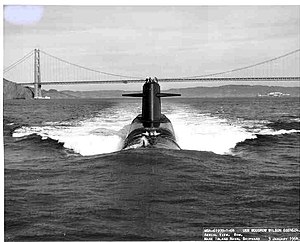Lafayette class submarine
|
Lafayette-class submarine USS Woodrow Wilson
|
|
| Class overview | |
|---|---|
| Name: | Lafayette class |
| Builders: | |
| Operators: |
|
| Preceded by: | Ethan Allen class |
| Succeeded by: | James Madison class |
| Built: | 1961–1964 |
| In commission: | 1963–1994 |
| Completed: | 9 |
| Retired: | 9 |
| Preserved: | 1 (As Training Vessel) |
| General characteristics | |
| Type: | Nuclear-powered Ballistic Missile Submarine |
| Displacement: |
Surfaced: 7,325 long tons (7,443 t) Submerged: 8,251 long tons (8,383 t) |
| Length: | 425 ft (130 m) |
| Beam: | 33 ft (10 m) |
| Draft: | 28 ft 6 in (8.69 m) |
| Propulsion: |
|
| Speed: |
|
| Test depth: | 1,300 feet (400 m) |
| Complement: | Two crews of 14 officers and 126 enlisted |
| Armament: | 16 Polaris A2/A3 or Poseidon C3 missiles, 4 × 21 inch (533 mm) torpedo tubes, 12 torpedoes |
Surfaced: 7,325 long tons (7,443 t)
The Lafayette class of submarine was an evolutionary development from the Ethan Allen class of fleet ballistic missile submarine, slightly larger and generally improved. This class, together with the George Washington, Ethan Allen, James Madison, and Benjamin Franklin classes, composed the "41 for Freedom," the Navy's primary contribution to the nuclear deterrent force through the late 1980s. The James Madison and Benjamin Franklin classes are combined with the Lafayettes in some references.
The first eight submarines initially deployed with the Polaris A-2 missile, later being refitted with the longer ranged Polaris A-3, with USS Daniel Webster (SSBN-626) having the A-3 missile from the start. In the mid-1970s all were upgraded to carry the Poseidon C3 missile; their missile tubes were slightly larger than the Ethan Allen and George Washington classes and Poseidon was designed to take advantage of this. Unlike twelve of the similar James Madison and Benjamin Franklin classes, none of the Lafayette-class submarines were refitted with Trident I (C4) missiles.
The Lafayettes and their successors were equipped with a hovering system to manage trim more effectively when firing missiles; this increased the missile rate of fire from one per minute to four per minute.
Daniel Webster was originally built with diving planes mounted on a "mini-sail" near the bow, leading to her nickname "Old Funny Fins". This configuration, unique to US submarines, was an attempt to reduce the effect of porpoising. While successful, the "mini-sail" required to contain the operating mechanism reduced hydrodynamic efficiency and lowered her overall speed. During a mid-1970s overhaul these unusual planes were removed and standard fairwater planes were installed.
...
Wikipedia

